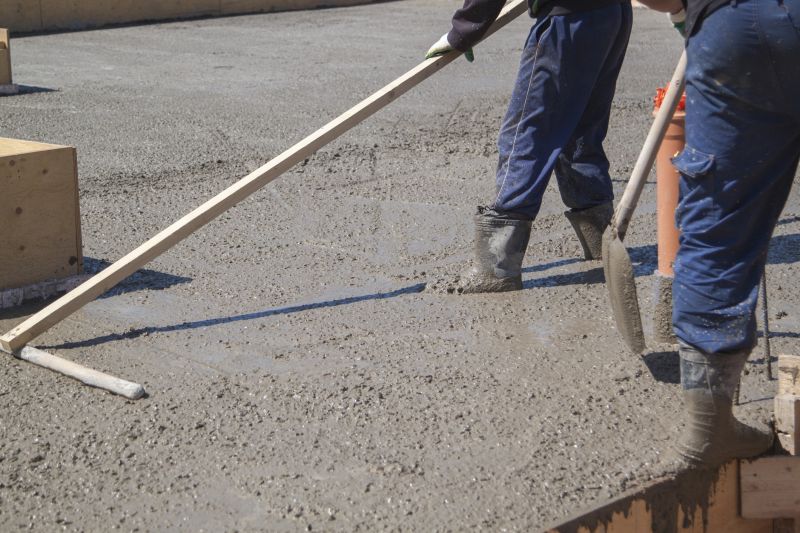Ultimate Guide To Concrete Leveling Products For DIY Enthusiasts
Find the essential products that help homeowners achieve professional-grade concrete leveling with ease and confidence.
 Concrete levelings are essential solutions for addressing uneven or sunken slabs, helping to restore safety and functionality to various surfaces. These products are designed to be versatile and effective, accommodating a range of repair needs from small residential patios to larger commercial walkways. When selecting products for concrete leveling, it's important to consider the specific condition of the slab, the underlying cause of the unevenness, and the desired longevity of the repair. Many options are available that cater to different application methods, such as self-leveling compounds, polyurethane foam injections, and mudjacking materials.
Concrete levelings are essential solutions for addressing uneven or sunken slabs, helping to restore safety and functionality to various surfaces. These products are designed to be versatile and effective, accommodating a range of repair needs from small residential patios to larger commercial walkways. When selecting products for concrete leveling, it's important to consider the specific condition of the slab, the underlying cause of the unevenness, and the desired longevity of the repair. Many options are available that cater to different application methods, such as self-leveling compounds, polyurethane foam injections, and mudjacking materials.
Top Overall Option
Polyurethane Foam Injection System
A polyurethane foam injection system offers a minimally invasive approach to concrete leveling, capable of lifting and stabilizing slabs with precision. This method is especially useful for residential and commercial applications where accuracy and quick turnaround are desired. The foam expands to fill voids beneath the slab, providing support and reducing the risk of future settling. Its lightweight nature and fast curing time make it a versatile choice for various project sizes and conditions.
Types of Products For Concrete Levelings
Self-Leveling Concrete Compounds
Fluid mixtures that spread evenly to create smooth, level surfaces, ideal for interior repairs and small outdoor patches.
Polyurethane Foam Injection Kits
Injectable foam systems designed to lift and stabilize sunken slabs with minimal disruption.
Mudjacking Slurry Mixes
A cement-based slurry used to fill voids and lift slabs, suitable for larger areas with significant settling.
Polymer-Based Slurries
Flexible, durable mixtures that can be pumped beneath slabs to provide support and fill voids.
Quick-Set Repair Mortars
Fast-curing mortars used for patching and leveling concrete surfaces quickly and efficiently.
Underlayment Pours
Specialized pourable products used beneath slabs to level uneven subgrades before final surface application.
Epoxy-Based Leveling Products
High-strength epoxy compounds used for repairing cracks and leveling surfaces with added durability.
Hydraulic Cement Mixes
Water-activated cements suitable for quick repairs and sealing cracks or voids.
Polymer-Modified Cements
Cements enhanced with polymers to improve adhesion, flexibility, and durability in leveling applications.
Rapid Curing Patching Compounds
Materials designed to set quickly for urgent repairs and immediate use of the surface.
Popular Choices
Widely used for their ability to precisely lift slabs with minimal surface disruption.
Popular for creating smooth, even surfaces on existing slabs, especially indoors.
Commonly selected for larger projects that require filling voids beneath concrete slabs.
Trendy for their versatility and ability to stabilize slabs with minimal excavation.
Preferred for quick turnaround repairs in busy areas or urgent situations.
Popular for leveling subgrades before final surface placement, ensuring stability.
Favored for crack repairs and surface leveling where added strength is desired.
Commonly used for quick sealing and repairs of cracks in concrete slabs.
Chosen for their flexibility and adhesion in leveling applications.
Ideal for projects requiring immediate use of the repaired surface.
Self-leveling compounds are popular for their ease of use and quick setting times, making them suitable for interior and exterior applications where a smooth, level surface is desired. Polyurethane foam injections are valued for their minimal invasive nature and ability to lift and stabilize slabs with precision, often used in residential driveways and sidewalks. Mudjacking involves pumping a slurry mixture beneath the slab to raise and stabilize it, offering a cost-effective solution for larger areas with significant settling.
Proper application of concrete leveling products can extend the lifespan of existing slabs and prevent further damage. It's essential to follow manufacturer instructions carefully, including surface preparation and curing times. Additionally, selecting the right product type depends on factors such as load-bearing requirements, weather conditions, and the extent of the unevenness. Consulting with a professional or conducting thorough research can help ensure the chosen solution meets specific project needs and provides a durable, safe surface for years to come.
Key Buying Considerations
- Determine the extent and cause of the unevenness to select the appropriate product type.
- Consider the size of the area needing repair to choose between small kits or larger equipment.
- Evaluate the load-bearing requirements of the slab to ensure the product provides sufficient support.
- Check surface compatibility, especially if the concrete surface is textured or coated.
- Review curing times to coordinate with project timelines and avoid delays.
- Assess weather conditions if working outdoors, as some products may require specific temperatures or humidity levels.
- Consider the ease of application and whether professional installation is recommended.
- Investigate the longevity and durability of the product for long-term stability.
- Look for products that offer minimal surface disruption, especially in high-traffic areas.
- Ensure compatibility with existing concrete and surrounding materials.
- Review safety instructions and required protective equipment during application.
- Compare costs relative to coverage area and expected performance.
- Check for any specific surface preparation requirements before application.
- Consider environmental factors such as moisture exposure or freeze-thaw cycles.
- Verify if the product is suitable for interior or exterior use, or both.
